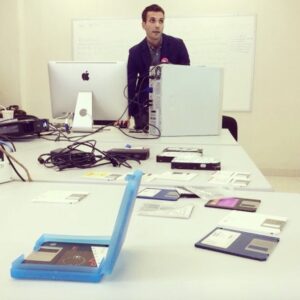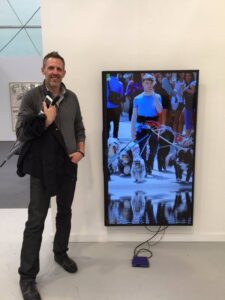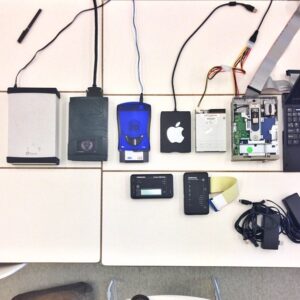Ben is a NYC based media archaeologist, archivist and conservator of born-digital and computer based works of contemporary art. He is the Associate Media Conservator at the Museum of Modern Art (MoMA). In this role, he develops strategies and policy that contribute to the preservation of the museum’s digital collections. He has also worked with the Whitney Museum, Cory Arcangel, JODI, Rhizome just to name a few.
We are thrilled that Ben has joined us as an Advisor and is working with us on a key part of the Niio platform – – digital preservation.

What do you believe are the biggest misconceptions about digital / moving image art and what would you like people to understand?
The idea that digital means immaterial. So often I hear collectors and institutions describe digital artworks as being fundamentally ephemeral and immaterial. This couldn’t be farther from the truth.
Take for instance Andrew Blum’s book Tubes: a Journey to the Center of the Internet – Blum travels around the world tracing and documenting the immense and complex physical infrastructure of the internet. An earlier example of this kind of hacker tourism / documentation is Neal Stephenson’s 1996 piece for Wired Mother Earth Mother Board, where Stephenson documents the gritty blood, sweat, and tears involved in laying a transcontinental fiber optic cable.
This same brutally physical reality exists when considering the storage of digital files. Let’s say you had 100 reels of 35mm film prints, and you digitized and digitally restored them. Are these now immaterial? You’ve now created roughly 206 TB of data. If you were going to stored these on LTO 6 tapes, they would take up 4,684 cubic feet, and would weigh a total of 37 Lbs (16.7) kg. If you stacked the tapes, they would be almost 6 feet tall. Is that immaterial? Absolutely not. Granted, the amount of physical space in the real world that a digital bit requires is very small – but it is still very much physical.
Do you see a time when digital art / time-based media is considered mainstream?
It is. I think we can all agree that MoMA is mainstream, no? The atrium at MoMA is most often the first gallery that visitors see when coming to the museum. Now, consider the kind of artworks that have been shown in this atrium – the most prominent space in the museum – in the last five years. I would estimate that 75% of the work has been at least partially time-based media.
How do you define mainstream? Will media art be mainstream when museums are selling Ryan Trecartin coffee mugs in museum gift shops? Is that something we even want?
What do you think about all the hype surrounding VR? Do you think it’s a tool that artists and museums will eventually embrace?
Artists of course started playing around with the various new VR platforms as soon as they could get their hands on them, and I think that the response on the part of museums has been rather rapid. MoMA in fact has been including VR in its curatorial programming, and it is only logical to suppose that it is just a matter of time before a VR work is collected.
Personally I approach anything that is hyped as hard as VR with a great deal of skepticism, but having tried various examples, it is absolutely an incredibly rich area for artistic exploration. The sensation is rather astounding.
As an artist yourself, what drew you to “digital” vs. a more traditional medium?
I’ve always been the kind of person who likes to take things apart, figure out how they work, put them back together (or not), and make something from the parts. I think that anyone with this predisposition is naturally attracted to working with computers, and time-based media in general.
Many of the professors I met in art school had been heavily involved in the upstate New York video art scene of the 60s and 70s – and they had built our studios accordingly. I became very immersed in real-time video synthesis and processing – hacking, circuit bending, custom electronics, etc. I was lucky enough to have spent time at the Experimental Television Center in the early 2000s, before it’s closure in 2011. Throughout this time I was still drawing, making sculpture, prints, painting, everything really. I was fortunate to have a very interdisciplinary art school experience.

What was the first piece of digital art you remember experiencing?
Either Paper Rad or Cory Arcangel
Who is doing really cutting edge work?
Tabor Robak continues to amaze
If you could own one piece of art, what would it be?
Any Ed Ruscha
Favorite museum (aside from MOMA)?
The New Museum is always a favorite for a weekend afternoon.
Favorite city for exploring art?
New York, naturally
Read Part 1 of our interview with Ben.

About Ben Fino-Radin
Ben is a NYC based media archaeologist, archivist and conservator of born-digital and computer based works of contemporary art. He is the Associate Media Conservator at the world-renowned Museum of Modern Art (MoMA). In this role, he develops strategies and policy that contribute to the preservation of the museum’s digital collections.
Prior to MoMA, Ben worked as a Digital Conservator at Rhizome at the New Museum where he structured preservation and collecting practices for collections management, documentation, and preservation of born-digital works of art. As an Adjunct professor at NYU’s Moving Image Archiving and Preservation (MIAP) program, Ben taught a course on Digital Literacy designed to equip first year graduate students with fundamental technical skills for careers in digital archives as well as Handling Complex Media, a course designed to give second year graduate students practical skills for the identification, risk assessment, preservation and treatment of creative works that employ complex and inherently unstable digital materials.
Research interests include: digital preservation, digital cultural heritage, web based creative communities, computer history, information architecture, metadata and animated gifs.
